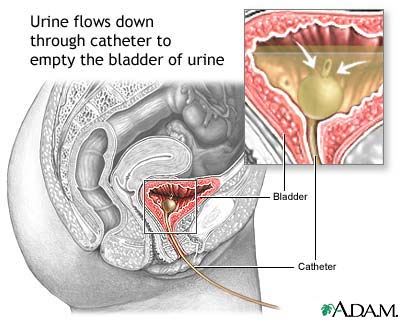Definition
A urinary tract infection, or UTI, is an infection that can happen anywhere along the urinary tract. Urinary tract infections have different names, depending on what part of the urinary tract is infected.
- Bladder — an infection in the bladder is also called cystitis or a bladder infection
- Kidneys — an infection of one or both kidneys is called pyelonephritis or a kidney infection
- Ureters — the tubes that take urine from each kidney to the bladder are only rarely the site of infection
- Urethra — an infection of the tube that empties urine from the bladder to the outside is called urethritis
See also:
- Cystitis – noninfectious
- Interstitial cystitis
- Urethritis
- Urinary tract infection – children
Overview, Causes, & Risk Factors
Urinary tract infections are caused by germs, usually bacteria that enter the urethra and then the bladder. This can lead to infection, most commonly in the bladder itself, which can spread to the kidneys.
Most of the time, your body can get rid of these bacteria. However, certain conditions increase the risk of having UTIs.
Women tend to get them more often because their urethra is shorter and closer to the anus than in men. Because of this, women are more likely to get an infection after sexual activity or when using a diaphragm for birth control. Menopause also increases the risk of a UTI.
The following also increase your chances of developing a UTI:
- Diabetes
- Advanced age (especially people in nursing homes)
- Problems emptying your bladder (urinary retention) because of brain or nerve disorders
- A tube called a urinary catheter inserted into your urinary tract
- Bowel incontinence
- Enlarged prostate, narrowed urethra, or anything that blocks the flow of urine
- Kidney stones
- Staying still (immobile) for a long period of time (for example, while you are recovering from a hip fracture)
- Pregnancy
Pictures & Images
Bladder catheterization, female A catheter (a hollow tube, often with an inflatable balloon tip) may be inserted into the urinary bladder when there is a urinary obstruction, following surgical procedures to the urethra, in unconscious patients (due to surgical anesthesia, coma, etc.), or for any other problem in which the bladder needs to be kept empty (decompressed) and urinary flow assured.
A catheter (a hollow tube, often with an inflatable balloon tip) may be inserted into the urinary bladder when there is a urinary obstruction, following surgical procedures to the urethra, in unconscious patients (due to surgical anesthesia, coma, etc.), or for any other problem in which the bladder needs to be kept empty (decompressed) and urinary flow assured.

Catheterization is accomplished by inserting a catheter (a hollow tube, often with and inflatable balloon tip) into the urinary bladder. This procedure is performed for urinary obstruction, following surgical procedures to the urethra, in unconscious patients (due to surgical anesthesia, coma, etc.), or for any other problem in which the bladder needs to be kept empty (decompressed) and urinary flow assured. Catheterization in males is slightly more difficult and uncomfortable than in females because of the longer urethra
Female urinary tract
The female and male urinary tracts are relatively the same except for the length of the urethra.
Male urinary tract|
The male and female urinary tracts are relatively the same except for the length of the urethra. Prevention of cystitis
Appropriate hygiene and cleanliness of the genital area may help reduce the chances of introducing bacteria through the urethra. Females are especially vulnerable to this, because the urethra is in close proximity to the rectum. The genitals should be cleaned and wiped from front to back to reduce the chance of dragging E. coli bacteria from the rectal area to the urethra. |
Review Date : 10/6/2009
Reviewed By : David C. Dugdale, III, MD, Professor of Medicine, Division of General Medicine, Department of Medicine, University of Washington School of Medicine. Also reviewed by David Zieve, MD, MHA, Medical Director, A.D.A.M., Inc.
![]()


